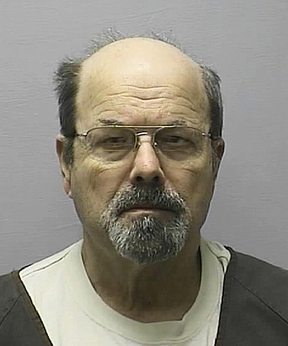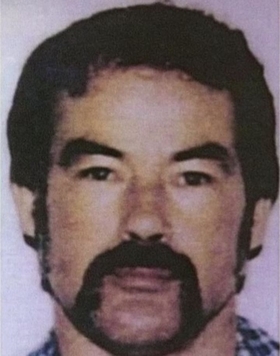
The Axeman of New Orleans was an unidentified American serial killer who was active in and around New Orleans, Louisiana, between May 1918 and October 1919. Press reports during the height of public panic over the killings mentioned similar crimes as early as 1911, but recent researchers have called these reports into question. The attacker was never identified, and the murders remain unsolved.

Dennis Lynn Rader, also known as BTK, is an American serial killer who murdered at least ten people in Wichita and Park City, Kansas, between 1974 and 1991. Although Rader occasionally killed or attempted to kill men and children, he typically targeted women. His victims were often bound, sometimes with objects from their homes, and either suffocated with a plastic bag or manually strangled with a ligature.

Sarah MacDiarmid was a 23-year-old Scottish-Australian woman who disappeared from Kananook railway station in Melbourne, Victoria, Australia on 11 July 1990. She is presumed murdered, although no trace of her body has ever been found.

Sture Ragnar Bergwall, also known as Thomas Quick from 1993–2002, is a Swedish man previously believed to have been a serial killer, having confessed to more than 30 murders while detained in a mental institution for personality disorders. Between 1994 and 2001, Quick was convicted of eight of these murders. However, he withdrew all of his confessions in 2008. As a result, his murder convictions were quashed, the final one in July 2013, and he was released from hospital. The episode raised issues about how murder convictions could have been obtained on such weak evidence, and has been called the largest miscarriage of justice in Swedish history. Journalists Hannes Råstam and Jenny Küttim and Dan Josefsson published TV documentaries and books about the murder cases; they claimed that bad therapy led to false confessions. Dan Josefsson claims that a "cult"-like group led by psychologist Margit Norell manipulated the police and talked Sture Bergwall into false confessions.
The backpacker murders were a spate of serial killings that took place in New South Wales, Australia, between 1989 and 1993, committed by Ivan Milat. The bodies of seven missing young people aged 19 to 22 were discovered partially buried in the Belanglo State Forest, 15 kilometres (9.3 mi) south-west of the New South Wales town of Berrima. Five of the victims were foreign backpackers and two were Australians from Melbourne. Milat was convicted of the murders on 27 July 1996 and was sentenced to seven consecutive life sentences, as well as 18 years without parole. He died in prison on 27 October 2019, having never confessed to the murders for which he was convicted.
This is a timeline of major crimes in Australia.
The Wanda Beach Murders, also known simply as "Wanda", were the unsolved murders of Marianne Schmidt and Christine Sharrock at Wanda Beach near Cronulla in Sydney, New South Wales, Australia, on 11 January 1965. The victims, both aged 15, were best friends and neighbours from the suburb of West Ryde, and their partially buried bodies were discovered the next day. The brutal nature of the slayings and the fact that they occurred on a deserted, windswept beach brought massive publicity to the case. By April 1966, police had interviewed some 7,000 people, making it the largest investigation in Australian history. It remains one of the most infamous unsolved Australian murder cases of the 1960s, and New South Wales' oldest unsolved homicide case.

Sensing Murder is a television show in which three psychics are asked to act as psychic detectives to help provide evidence that might be useful in solving famous unsolved murder cases by communicating with the deceased victims. The program format was developed in 2002 by Nordisk Film TV in Denmark and has been sold to many countries including Australia, Belgium, Canada, Hungary, the Netherlands, New Zealand, Norway, Sweden, and the US. In 2004, Granada Entertainment bought the US rights. The New Zealand series first aired in 2006 and was hosted by Rebecca Gibney. On 17 January 2017, it was announced that Amanda Billing would be the new host for the Australia/New Zealand version.

Christopher Bernard Wilder, also known as the Beauty Queen Killer and the Snapshot Killer, was an Australian-American serial killer who abducted at least twelve young women and girls, killing eight of them during a six-week, cross-country crime spree in the United States in early 1984. Wilder's series of murders began in Florida on February 26, 1984, and continued across the country through Texas, Oklahoma, Colorado, Nevada and California, with attempted abductions in Washington and New York. Wilder victimized attractive young women, most of whom he would entice by promising to take their pictures. After subduing them, he would torture and rape them before shooting, stabbing with a knife, or strangling them to death. Two or more of his victims were electrocuted using a makeshift electrical cord.
A familicide is a type of murder or murder-suicide in which an individual kills multiple close family members in quick succession, most often children, spouses, siblings, or parents. In half the cases, the killer lastly kills themselves in a murder-suicide. If only the parents are killed, the case may also be referred to as a parricide. Where all members of a family are killed, the crime may be referred to as family annihilation.

Steven Gerald James Wright is an English serial killer, also known as the Suffolk Strangler. He is currently serving life imprisonment for the murder of five women who worked in Ipswich, Suffolk. The killings took place during the final months of 2006 and Wright was found guilty in February 2008 and given a whole life order

Crime Investigation Australia is an Australian true-crime series that first premiered on pay TV Foxtel's Crime & Investigation Network in August 2005. The series was also rebroadcast on the free to air Nine Network, and made its debut there on 14 August 2007. The original host of the series was Steve Liebmann and is currently on Channel 7 with host Matt Doran.

Peter Britton Tobin was a Scottish convicted serial killer and sex offender who served a whole life order at HM Prison Edinburgh for three murders committed between 1991 and 2006. Police also investigated Tobin over the deaths and disappearances of other young women and girls.

Ivan Robert Marko Milat, commonly referred to in media as the Backpacker Murderer, was an Australian serial killer who abducted, assaulted, robbed and murdered two men and five women in New South Wales between 1989 and 1992. His modus operandi was to approach backpackers along the Hume Highway under the guise of providing them transport to areas of southern New South Wales, then take his victims into the Belanglo State Forest where he would incapacitate and murder them. Milat is also suspected of having committed many other similar offences and murders around Australia.
The murders of Margaret Tapp and Seana Tapp, sometimes simply referred to as the Tapp murders, are unsolved crimes that occurred on 7 August 1984. The murders have been described as one of the most notorious unsolved murder cases in Australian history.

Joseph William Kappen, also known as the Saturday Night Strangler, was a Welsh serial killer who committed the rape and murder of three teenage girls in Llandarcy and Tonmawr, near his home town of Port Talbot, in 1973. Kappen is also suspected of committing a fourth murder in February 1976.












